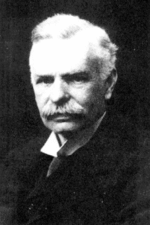Richard Dixon Oldham
Richard Dixon Oldham FRS (/ˈoʊldəm/; 31 July 1858 – 15 July 1936) was a British geologist who made the first clear identification of the separate arrivals of P-waves, S-waves and surface waves on seismograms and the first clear evidence that the Earth has a central core.
Richard Dixon Oldham | |
|---|---|
 Richard Dixon Oldham | |
| Born | 31 July 1858 |
| Died | 15 July 1936 (age 77) |
| Nationality | United Kingdom |
| Known for | measuring Earth's core; separate arrival of seismic phases |
| Scientific career | |
| Fields | geologist |
Life
Born on 31 July 1858 to Thomas Oldham, a Fellow of the Royal Society and geologist, Oldham was educated at Rugby School and the Royal School of Mines. [1]
In 1879 Oldham became an assistant-superintendent with the Geological Survey of India, working in the Himalayas. He wrote about 40 publications for the Survey on geological subjects including hot springs, the geology of the Son Valley and the structure of the Himalayas and the Ganges plain. His most famous work was in seismology. His report on the 1897 Assam earthquake went far beyond reports of previous earthquakes. It included a description of the Chedrang fault, with uplift up to 35 feet and reported accelerations of the ground that had exceeded the Earth's gravitational acceleration. His most important contribution to seismology was the first clear identification of the separate arrivals of P-waves, S-waves and surface waves on seismograms. Since these observations agreed with theory for elastic waves, they showed that the Earth could be treated as elastic in studies of seismic waves.[2]
In 1903, Oldham resigned from the GSI due to ill-health and returned to the United Kingdom, living in Kew and various parts of Wales.[3]:110 In 1906 he wrote a paper analyzing seismic arrival times of various recorded earthquakes. He concluded that the earth had a core and estimated its radius to be less than 0.4 times the radius of the Earth.[1][4]
In 1908 Oldham was awarded the Lyell Medal, in 1911 made a Fellow of the Royal Society,[3] and from 1920 to 1922 served as the President of the Geological Society of London, dying on 15 July 1936.[3]:113
Publications
| Wikisource has original works written by or about: Richard Dixon Oldham |
- Oldham, R. D. (1899). "Report of the great earthquake of 12th June, 1897". Memoirs of the Geological Society of India. 29. K. Paul, Trench, Trübner & co.CS1 maint: ref=harv (link)
- Oldham, R. D. (1900). "On the Propagation of Earthquake Motion to Great Distances". Philosophical Transactions of the Royal Society A. 194: 135–174. Bibcode:1900RSPTA.194..135O. doi:10.1098/rsta.1900.0015.CS1 maint: ref=harv (link)
- Oldham, R. D. (1906). "The Constitution of the Interior of the Earth, as Revealed by Earthquakes". Quarterly Journal of the Geological Society. 62 (1–4): 456–475. doi:10.1144/GSL.JGS.1906.062.01-04.21.CS1 maint: ref=harv (link)
- A bibliography of Indian geology; being a list of books and papers, relating to the geology of British India and adjoining countries, published previous to the end of A.D. 1887
See also
- Harold Jeffreys – showed that Earth's outer core is liquid
- Inge Lehmann – showed that Earth's inner core is solid
- List of geophysicists
References
- Bragg, W. (1936). "Tribute to deceased fellows of the Royal Society". Science. 84 (2190): 539–546. Bibcode:1936Sci....84..539B. doi:10.1126/science.84.2190.539. PMID 17834950.CS1 maint: ref=harv (link)
- "Oldham, Richard Dixon". Complete Dictionary of Scientific Biography. 10. Charles Scribner's Sons. 2008. p. 203.
- Davison, C. (1936). "Richard Dixon Oldham. 1858-1936". Obituary Notices of Fellows of the Royal Society. 2 (5): 111–113. doi:10.1098/rsbm.1936.0008.CS1 maint: ref=harv (link)
- Oldham 1906